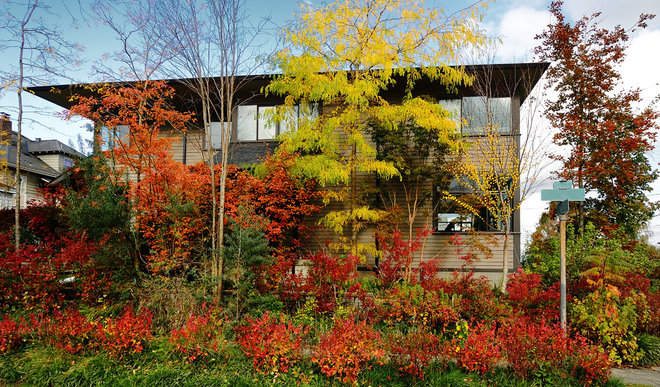Fall is a good time to take care of big home repair projects before shorter days (and in many areas, ice and snow) make outdoor work too difficult. And if you do live in an area with cold winters, take some time this fall to boost energy efficiency throughout your home and prevent damage from winter storms with proper tree care. (We spoke with an expert to find out what you need to do.) Tick these items off your list this season, and you can rest easy knowing that your home and yard are buttoned up and ready for winter.
Tasks to Check Off Your List in an Hour or Less
Stock up on winter supplies. If you live in a region with cold, snowy winters, fall is the time to prepare.
Stock up on winter supplies. If you live in a region with cold, snowy winters, fall is the time to prepare.
- Check the condition of snow shovels and ice scrapers; replace as needed.
- Pick up a bag of pet- and plant-safe ice melt, if needed.
- Restock emergency kits for car and home.
- If you use a snow blower, have it serviced and purchase fuel.
Check walkways, railings, stairs and the driveway for winter safety. When the landscape is covered in ice and snow, just walking from the driveway to the front door can be a challenge.
Make navigating around your home safer by checking that all stairs are in good shape and have sturdy railings, and that the driveway is in good repair to make for easier shoveling.
Test outdoor lights and replace bulbs as needed. As the days get shorter we rely more on exterior lighting, both for safety and ambiance. Test lights on the front and back porch, on the garage and in the landscape, and replace bulbs as needed.
Make navigating around your home safer by checking that all stairs are in good shape and have sturdy railings, and that the driveway is in good repair to make for easier shoveling.
Test outdoor lights and replace bulbs as needed. As the days get shorter we rely more on exterior lighting, both for safety and ambiance. Test lights on the front and back porch, on the garage and in the landscape, and replace bulbs as needed.
Check safety devices.
- Test smoke detectors and carbon monoxide detectors; replace batteries as needed.
- Check the expiration date on your fire extinguisher and replace if needed.
- If you haven’t checked your home for radon, fall is a good time to do so — as the weather gets cooler and windows stay shut more often, radon is more likely to become trapped in your home.
- Radon at high enough levels is extremely harmful, so if you find that your home has radon (a radon level of 4 or above is considered unacceptable by the Environmental Protection Agency), hire a contractor qualified to fix radon issues.
Vacuum radiators, baseboard heaters and grates. Get ready for heating season by clearing away dust and grime from radiators, baseboard heaters and heating grates. If your radiators have removable covers, take them off and vacuum beneath the cover before replacing.
Remove window A/C units. If you use window air conditioning units in the summer, remove them before the weather turns cold. If you must leave in window A/C units, cover the exterior of the unit with an insulating wrap to keep cold air out.
Remove window A/C units. If you use window air conditioning units in the summer, remove them before the weather turns cold. If you must leave in window A/C units, cover the exterior of the unit with an insulating wrap to keep cold air out.
Tackle These To-Dos Over a Weekend
Rake leaves. Leaves look beautiful blanketing the ground, but leaving too many leaves on a lawn over winter in a snowy area can inhibit spring growth. To make the job easier, choose a lightweight rake, wear gloves to protect your hands and use handheld “leaf scoops” to bag leaves quickly.
Seal gaps where critters could enter. Mice need only a tiny gap to be able to sneak into your house and raid your pantry. And with colder weather coming, all of the little critters out there will be looking for warm places to make a home. Fill small holes and cover any larger gaps securely with heavy-duty hardware cloth to keep the wildlife outdoors.
Rake leaves. Leaves look beautiful blanketing the ground, but leaving too many leaves on a lawn over winter in a snowy area can inhibit spring growth. To make the job easier, choose a lightweight rake, wear gloves to protect your hands and use handheld “leaf scoops” to bag leaves quickly.
Seal gaps where critters could enter. Mice need only a tiny gap to be able to sneak into your house and raid your pantry. And with colder weather coming, all of the little critters out there will be looking for warm places to make a home. Fill small holes and cover any larger gaps securely with heavy-duty hardware cloth to keep the wildlife outdoors.
Care for trees and shrubs. If you have trees on your property, consider hiring an arborist to care for them. These pros can spot signs of poor health early on to prevent tree loss. And they know how to prune properly to avoid falling limbs in winter storms.
“The most important maintenance for a homeowner to do in the fall would be trimming [the] dead out of trees,” says Bryan Gilles, owner and arborist at Arbor Doctor in Calabasas, California. “Trees are going dormant at this time, and are less likely to get a disease.” Because trees are slowing growth in the fall, it’s not an ideal time to plant a new tree, as the roots may have trouble getting established. For treatments, Gilles recommends fungicide injections in the fall to prevent diseases such as diplodia, which can affect pine trees.
It’s also a good idea to observe your trees throughout the fall, keeping an eye out for signs that signal a need for intervention. “Early change in leaf color, pines looking thin and/or needles turning brown, and dead branches are all signs of diseases,” Gilles says. “Ash trees spotting yellow sporadically around this time of the year is a bad sign of a disease called ash yellows, since ash trees are one of the latest to turn.”
“The most important maintenance for a homeowner to do in the fall would be trimming [the] dead out of trees,” says Bryan Gilles, owner and arborist at Arbor Doctor in Calabasas, California. “Trees are going dormant at this time, and are less likely to get a disease.” Because trees are slowing growth in the fall, it’s not an ideal time to plant a new tree, as the roots may have trouble getting established. For treatments, Gilles recommends fungicide injections in the fall to prevent diseases such as diplodia, which can affect pine trees.
It’s also a good idea to observe your trees throughout the fall, keeping an eye out for signs that signal a need for intervention. “Early change in leaf color, pines looking thin and/or needles turning brown, and dead branches are all signs of diseases,” Gilles says. “Ash trees spotting yellow sporadically around this time of the year is a bad sign of a disease called ash yellows, since ash trees are one of the latest to turn.”
Deep-clean the kitchen. Take a day to tackle some of the more labor-intensive cleaning tasks, and keep your kitchen working efficiently and looking great:
- Degrease the range hood and filter.
- Clean the oven.
- Vacuum the refrigerator coils.
- Scrub tile grout.
- Clean light fixtures.
- Wash the walls and backsplash.
- Wash the garbage can and recycling bins.
- Clean small appliances.
Add weatherstripping. Weatherstripping applied around the frames of windows and doors helps boost winter warmth and cut energy costs. Add door sweeps to the base of drafty doors to keep heat in and cold air out. If you’re feeling crafty, you can even make your own cozy draft stopper from an old flannel shirt, wool sweater or fleece blanket:
1. Cut a length of material about 3 inches longer than the width of your door (to allow for seams) and 6 to 8 inches wide.
2. Fold the material lengthwise, with right sides together.
3. Stitch a seam (by hand or on a sewing machine) down the long side, creating a tube of fabric. Stitch one end closed.
4. Turn the draft stopper right side out so the seams are hidden on the inside (use a yardstick or wooden spoon to get it completely turned right side out).
5. Fill with dry rice or beans.
6. Fold the open ends under and sew shut.
1. Cut a length of material about 3 inches longer than the width of your door (to allow for seams) and 6 to 8 inches wide.
2. Fold the material lengthwise, with right sides together.
3. Stitch a seam (by hand or on a sewing machine) down the long side, creating a tube of fabric. Stitch one end closed.
4. Turn the draft stopper right side out so the seams are hidden on the inside (use a yardstick or wooden spoon to get it completely turned right side out).
5. Fill with dry rice or beans.
6. Fold the open ends under and sew shut.
Clean dryer vents. Lint buildup in dryer vents can make your dryer work less efficiently and even cause a fire — cool, dry fall weather increases static electricity, which can ignite lint that has built up, so now is a key time to get that lint out. You can hire a duct cleaning specialist to clean the vents for you, or clean the vent yourself. If you decide to do it yourself:
1. Unplug your dryer.
2. Shut off the gas if you have a gas dryer.
3. Pull the dryer slightly away from the wall.
4. Loosen the clamp holding the hose.
5. Use a vacuum attachment or lint brush made for dryer hoses to clean out the hose and behind the dryer.
6. Replace the hose, gently move the dryer to the wall (without crushing the hose) and plug it in.
1. Unplug your dryer.
2. Shut off the gas if you have a gas dryer.
3. Pull the dryer slightly away from the wall.
4. Loosen the clamp holding the hose.
5. Use a vacuum attachment or lint brush made for dryer hoses to clean out the hose and behind the dryer.
6. Replace the hose, gently move the dryer to the wall (without crushing the hose) and plug it in.
Maintenance and Extras to Budget for This Month
Make exterior repairs. Take a walk around your property, looking for signs of damage to the roof, siding and foundation. If you spot anything that needs repair, schedule it before winter weather hits.
Clean gutters and downspouts. Once most of the leaves have fallen, clean out gutters and downspouts (hire a helper if you are not comfortable on a ladder). Clogged gutters during rainstorms can cause water to pool and damage your roof or siding.
Make exterior repairs. Take a walk around your property, looking for signs of damage to the roof, siding and foundation. If you spot anything that needs repair, schedule it before winter weather hits.
Clean gutters and downspouts. Once most of the leaves have fallen, clean out gutters and downspouts (hire a helper if you are not comfortable on a ladder). Clogged gutters during rainstorms can cause water to pool and damage your roof or siding.
Conduct an energy audit. A trained auditor can assess your home’s current energy efficiency and give you a list of recommended improvements you can make, which may include upgrading to Energy Star appliances, adding insulation to the attic or beefing up weatherstripping. You can also find instructions for a do-it-yourself energy audit at Energy.gov.
Schedule a chimney cleaning and heating system maintenance. Making sure your chimney and furnace or boiler are cleaned, maintained and in working order before you need to turn on the heat is an important safety measure. And be sure to add a chimney cap if you don’t already have one — it will stop critters from crawling down your chimney!
Schedule a chimney cleaning and heating system maintenance. Making sure your chimney and furnace or boiler are cleaned, maintained and in working order before you need to turn on the heat is an important safety measure. And be sure to add a chimney cap if you don’t already have one — it will stop critters from crawling down your chimney!
www.teambluesky.ca



No comments:
Post a Comment